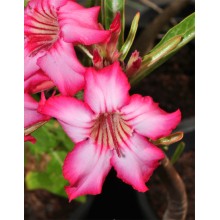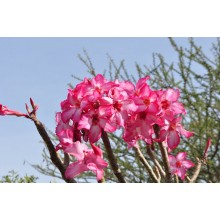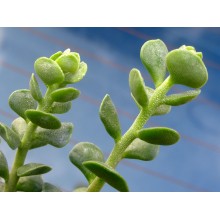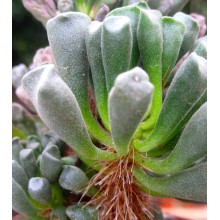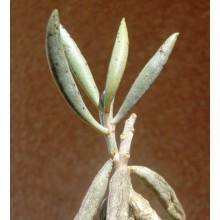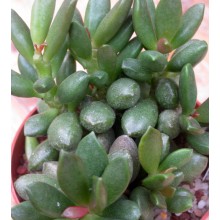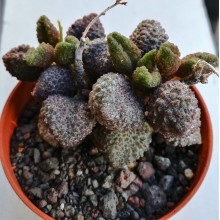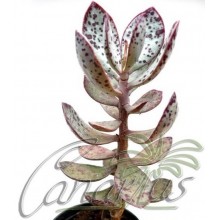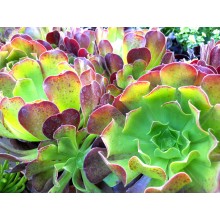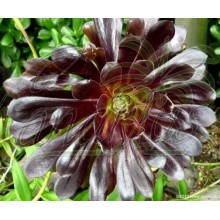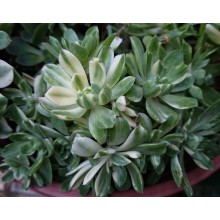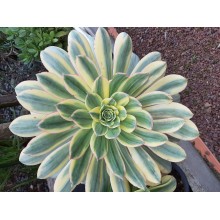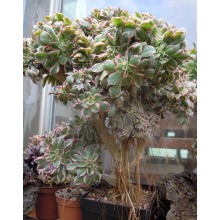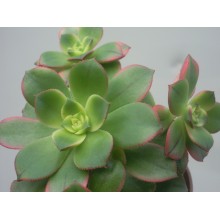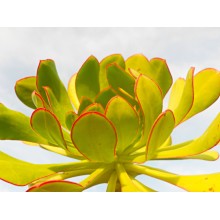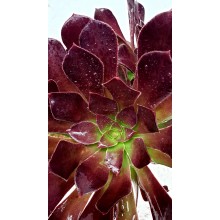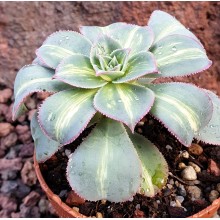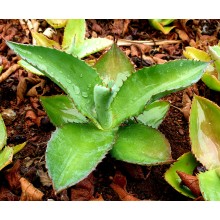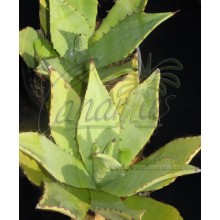Succulents There are 628 products.

World deserts and dry areas are home to the most interesting plants. Canarius offers an increasing selection of succulent plants of maximum quality, because they are grown outdoors, under the full sun of the Canary Islands.
Succulents or "fat plants" are water-retaining species, adapted to dry conditions. They store succum (juice, water) in their leaves, stems or roots, and often show a stout and fleshy appearance.
Subcategories
-
Agave
Agave is a genus of succulent plants from America. Some species grow in cold areas and take hard frost, while some others live in tropical climates. Some are tiny dwarfs and some are giants, up to 2 or 3 m wide.
Cold hardy agaves can create an exotic effect in your garden. Agave species make fine companions to palms or cacti. Variegated agaves are incredibly sought after by collectors. Our web shop offers an ever changing selection of species. We ship bare rooted plants, unless otherwise specified.
-
Aloe, Gasteria & Haworthia
Aloe, Gasteria and Haworthia are three related genera, comprising hundreds of succulent plants. They are all easily grown in pots. A few adapt to low-light levels of indoor conditions and can be grown as house plants.
- Aloe is a genus of about 400 species, native to Africa, Arabia and Madagascar. Small or dwarf aloes are becoming especially popular in colder climates as they can be taken indoors during the hardest months.
- Gasteria includes some 80 species endemic to South Africa, known for their spectacular leaves which are glossy, mottled and textured. They bloom in Spring-Summer with long spikes of small orange flowers. Some species are so variable that we offer particular clones from specific locations.
- Haworthia is a genus endemic to South Africa with about 70 species and a number of local subspecies, varieties and forms. Leaves are often banded, speckled, dotted, or semi-translucent and show wide variations.
-
Crassulaceae
This is a new, growing section of species from the family Crassulaceae. There are about 1,400 species in 33 genera and their distribution is worldwide, but mostly occur in the Northern Hemisphere and Southern Africa, especially in dry habitats. Here you can buy healthy, sun-hardened plants grown in the Canary Islands and shipped to your home.
-
Mesembs
This group of desert plants is briefly named Mesembs because they belong to a botanical family formerly named Mesembryanthemaceae. There are almost 2.000 species, mainly found in Southern Africa, with extreme adaptations to dry habitats. Some are called "living stones", as they look like pebbles. Many are easy to grow and their main need is full sun. Some are difficult because they grow in truly extreme areas.
Our Web Shop offers sun grown healthy plants, with compact and colourful leaves. Some plants are sold as cuttings, and others as rooted plants, of at least two years old.
-
Sansevieria
Recently assigned to the family Asparagaceae, the genus Sansevieria counts about 70 species, nearly all native to Africa, Arabia and Madagascar. Perennial herbs adapted to dry habitats with stiff, succulent leaves, their length ranges from a few centimeters to 2 meters. Sansevieria trifasciata and its many cultivars are among the most popular houseplants, popularly called mother in law's tongue. A well grown plant usually produces a spike of many white, richly scented flowers and then orange berries. Even the rarest species are resistant to neglect, provided you keep them from frost in winter and scorching sun in summer.
-
Hoya
Hoyas are twining vines, with showy exotic flowers, from the rainforests in Asia and Oceania. Most species grow in bright shade or morning sun, but they will also grow indoors as house plants. They are well suited for baskets, trellises or ladders. They tolerate a few weeks of drought but they are sensitive to frost and cold. Many hoyas are easy to grow and bloom, while some are tricky and rare.
-
Asclepiads
Asclepiads or Asclepiadoideae are a subfamily in the Apocynaceae, with about 2900 species. There are lots of leafless stem succulents but also perennial herbs, shrubs, lianas or rarely trees. They produce remarkable flowers, for the complex mechanisms they have developed for pollination. Many species produce an unusual fragrance, often called "carrion", and attracts flies for pollination. -
Caudiciforms
These plants from dry areas produce an unusually thick stem, the caudex. They are also called pachycauls and they have a disproportionately thick trunk, often with few branches. The caudex can be hidden underground, but in most cases they grow upwards, forming spectacular trees. The largest caudiciforms in the world are the baobabs. -
Other succulents
Here you will find all those species of desert plants that are not included in their own category. We will place here all plants from unusual families, other than Agaves, Aloes, Crassulaceae, Sansevieria, Mesembs, Epiphytic cacti, etc.
-
Adenium somalense Isiolo
Adenium somalense Isiolo
Not all Adenium somalense grow in Somalia. This material was originally collected North of Isiolo, in Kenya. In this region, these adeniums grow very tall, to 4 m, with spectacular gnarled stems.
28,70 € -
Adenium somalense- Large 3
Adenium somalense- Large 3
Adenium somalense is one of the most beautiful caudiciform plants. It grows wild in Somalia and through the Rift Valley into Ethiopia, Kenya, and Tanzania. Depending on the area, its trunk can take different shapes from a fat shrub to a small tree (more than 4 m), differently from the similar species A. obesum whose caudex is mainly underground. The showy...
75,00 € -
Adromischus caryophyllaceus CG62 Robertson
Adromischus caryophyllaceus CG62 Robertson
Beautiful Adromischus with erect branches and round-spathulate leaves, coated with a blueish-grey wax. It bears in summer relatively large flowers with purple mid-stripes.This clone was collected in Robertson, in the Western Cape and recorded as CG62.
10,20 € -
Adromischus cooperi
Adromischus cooperi
Large, branched, cont.= 8,5 cm - A slow growing South African species with swollen purple leaves, with grey-purple blotches, and undulating leaf apex. It will enjoy some light shade in the hottest months.
12,20 € -
Adromischus cristatus var. clavifolius
Adromischus cristatus var. clavifolius
Large, Branched Plant - Easy but slow South African succulent with "hairy" stems. These hairs are showy reddish-brown aerial roots. This clone has spathulate leaves with apical margin undulate.
10,20 € -
Adromischus filicaulis ssp. filicaulis
Adromischus filicaulis ssp. filicaulis
This Adromischus has long grey leaves, more or less spotted, on erect stems. It is another variable species of this interesting genus.
10,20 € -
Adromischus mamillaris
Adromischus mamillaris
This is a low-growing Adromischus, densely branching, with grey-green pointed leaves, only mildly mottled. This South African species has the widest geographical distribution in the genus.
10,20 € -
Adromischus marianae v. herrei
Adromischus marianae v. herrei
Weird beauty from the South African desert. It is a must for collectors of Crassulaceae or extreme succulent plants. This Adromischus has short dark leaves with an incredibly rough surface which is a masterpiece of nature. It changes colours through the seasons from green to brown, red or more.
12,30 € -
Adromischus triflorus
Adromischus triflorus
Pot = 8,5 cm. Variable species native to South Africa. It forms clusters with thick, silvery green leaves. This form has ovate-pointed leaves with abundant reddish speckles, tending to become more intense in bright light.
12,20 € -
Aeonium arboreum cv. Purpureum
Aeonium arboreum cv. Purpureum
A garden selection with leaves stained with purple tips and spots.
10,20 € -
Aeonium arboreum cv. Zwartkop
Aeonium arboreum cv. Zwartkop
h= 10 cm - Cont.= 8,5 cm. The black aeonium is an old classic cultivar. Rosettes have burgundy-black leaves and the bright yellow inflorescence make a showy contrast.
11,80 € -
Aeonium castello-paivae cv. Suncup
Aeonium castello-paivae cv. Suncup
A beautiful variegated selection, well-striped in different tones of jade. It is one of the smallest species of Aeonium but it branches with multiple offsets. It is a tender soft succulent, and will not tolerate frost.
11,20 € -
Aeonium cv. Sunburst
Aeonium cv. Sunburst
Robust, rooted, unbranched plant. An incredible rainbow of colour! This aeonium is the boldest of all. Each leaf has a painting of dark green, jade, white and pink.
10,20 € -
Aeonium decorum f. cristata variegata
Aeonium decorum f. cristata variegata
Variegated AND crested. This plant is truly unusual and will slowly become a bonsai-like tree structure. The natural form of this species is originally native to the Canary Islands.
10,20 € -
Aeonium decorum tricolor 'Kiwi'
Aeonium decorum tricolor 'Kiwi'
Colourful selection of a branched Aeonium, with "rainbow" rosettes. Easy growing, it is probably a clone of the widespread A. decorum, native to the island of La Gomera, in the Canary Islands.
10,20 € -
Aeonium urbicum
Aeonium urbicum
Beautiful succulent plant endemic to Tenerife. This species of Aeonium does not branch, it grows upright and it bears a huge piramidal inflorescence. "Urbicum" means "urban", because it is often seen growing among tiles on the roofs of the city of La Laguna, in an "urban environment".
10,20 € -
Aeonium x 'Blushing Beauty'
Aeonium x 'Blushing Beauty'
Colourful classic hybrid, germinated in 1976 in Southern California by Jack Catlin, who crossed Aeonium canariense with Aeonium arboreum 'Zwartkop'.
10,20 € -
Aeonium x 'Lemon and Lime'
Aeonium x 'Lemon and Lime'
h= 10 cm - Cont.= 8,5 cm. It is a spectacular American hybrid of Aeonium decorum. It is characterised by the yellow band along the centre of its leaf. It ends with pink serrated edges. The rosette can be up to 30 cm wide.
15,30 € -
Agave abisaii
Agave abisaii
New Agave species described in 2013 within the "marmorata group".
21,30 € -
Agave albescens
Agave albescens
One of the few grey leaved agaves from the Caribbean islands. Mid-sized elegant rosette, with grey-yellow leaves and dark spines. It is an uncommon species endemic to the rocky hills of SE Cuba. It can be kept small in a pot for years.
21,30 €
At the moment there are few products in this category Succulents

























